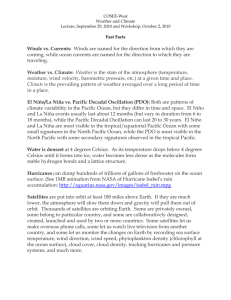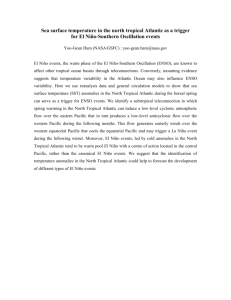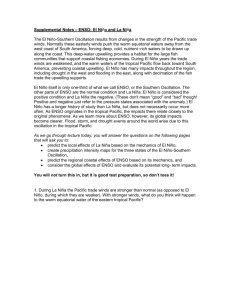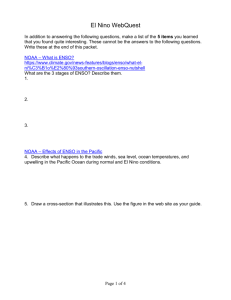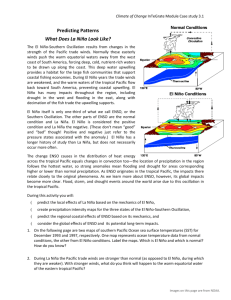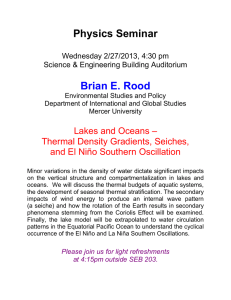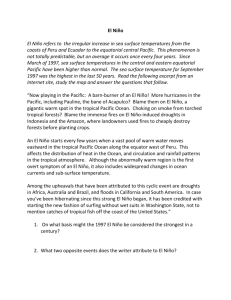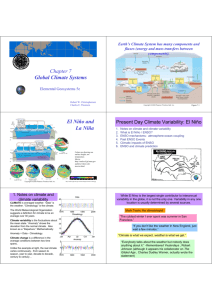Climate Resources for Field Ornithologists:
advertisement
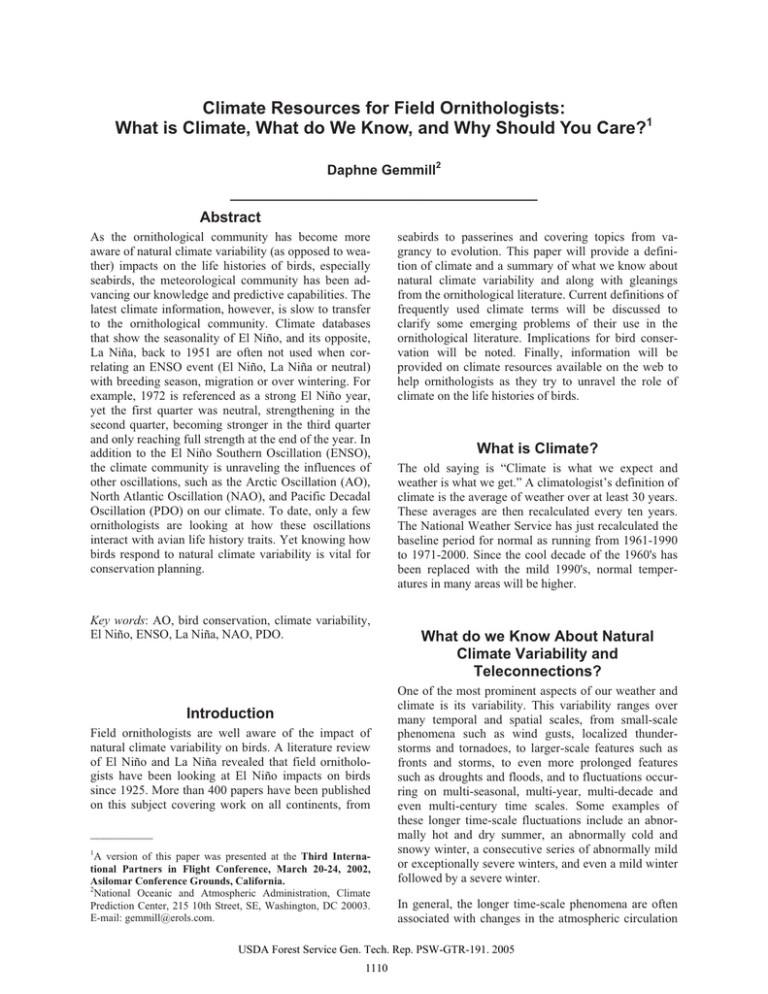
Climate Resources for Field Ornithologists: What is Climate, What do We Know, and Why Should You Care?1 Daphne Gemmill2 ________________________________________ Abstract As the ornithological community has become more aware of natural climate variability (as opposed to weather) impacts on the life histories of birds, especially seabirds, the meteorological community has been advancing our knowledge and predictive capabilities. The latest climate information, however, is slow to transfer to the ornithological community. Climate databases that show the seasonality of El Niño, and its opposite, La Niña, back to 1951 are often not used when correlating an ENSO event (El Niño, La Niña or neutral) with breeding season, migration or over wintering. For example, 1972 is referenced as a strong El Niño year, yet the first quarter was neutral, strengthening in the second quarter, becoming stronger in the third quarter and only reaching full strength at the end of the year. In addition to the El Niño Southern Oscillation (ENSO), the climate community is unraveling the influences of other oscillations, such as the Arctic Oscillation (AO), North Atlantic Oscillation (NAO), and Pacific Decadal Oscillation (PDO) on our climate. To date, only a few ornithologists are looking at how these oscillations interact with avian life history traits. Yet knowing how birds respond to natural climate variability is vital for conservation planning. Key words: AO, bird conservation, climate variability, El Niño, ENSO, La Niña, NAO, PDO. Introduction Field ornithologists are well aware of the impact of natural climate variability on birds. A literature review of El Niño and La Niña revealed that field ornithologists have been looking at El Niño impacts on birds since 1925. More than 400 papers have been published on this subject covering work on all continents, from __________ 1 A version of this paper was presented at the Third International Partners in Flight Conference, March 20-24, 2002, Asilomar Conference Grounds, California. 2 National Oceanic and Atmospheric Administration, Climate Prediction Center, 215 10th Street, SE, Washington, DC 20003. E-mail: gemmill@erols.com. seabirds to passerines and covering topics from vagrancy to evolution. This paper will provide a definition of climate and a summary of what we know about natural climate variability and along with gleanings from the ornithological literature. Current definitions of frequently used climate terms will be discussed to clarify some emerging problems of their use in the ornithological literature. Implications for bird conservation will be noted. Finally, information will be provided on climate resources available on the web to help ornithologists as they try to unravel the role of climate on the life histories of birds. What is Climate? The old saying is “Climate is what we expect and weather is what we get.” A climatologist’s definition of climate is the average of weather over at least 30 years. These averages are then recalculated every ten years. The National Weather Service has just recalculated the baseline period for normal as running from 1961-1990 to 1971-2000. Since the cool decade of the 1960's has been replaced with the mild 1990's, normal temperatures in many areas will be higher. What do we Know About Natural Climate Variability and Teleconnections? One of the most prominent aspects of our weather and climate is its variability. This variability ranges over many temporal and spatial scales, from small-scale phenomena such as wind gusts, localized thunderstorms and tornadoes, to larger-scale features such as fronts and storms, to even more prolonged features such as droughts and floods, and to fluctuations occurring on multi-seasonal, multi-year, multi-decade and even multi-century time scales. Some examples of these longer time-scale fluctuations include an abnormally hot and dry summer, an abnormally cold and snowy winter, a consecutive series of abnormally mild or exceptionally severe winters, and even a mild winter followed by a severe winter. In general, the longer time-scale phenomena are often associated with changes in the atmospheric circulation USDA Forest Service Gen. Tech. Rep. PSW-GTR-191. 2005 1110 Climate Resources for Ornithologists - Gemmill that encompass areas far larger than a particular affected region. At times, these persistent circulation features occur simultaneously over vast, and seemingly unrelated, parts of the globe, and result in abnormal weather, temperature and rainfall patterns throughout the world, known as teleconnections. El Niño-Southern Oscillation (ENSO) During the past several decades, scientists have discovered that important aspects of this interannual variability in global weather patterns are linked to a global-scale, naturally occurring phenomenon known as the El Niño-Southern Oscillation (ENSO) cycle. Originally, ENSO referred only to the combined atmosphere/ocean system during an El Niño warm event. Currently, it refers to the cold La Niña, warm El Niño and neutral phase of the cycle. (See http://www.cpc .ncep.noaa.gov/products/analysis_monitoring/lanina/ for more information). Warm episodes (El Niño) tend to occur every 4-5 years, and usually last between 12 and 18 months. Not all El Niño episodes are alike. They vary in intensity from weak to very strong, with impacts that also vary considerably from event to event. (See http://www.cpc .ncep.noaa.gov/products/analysis_monitoring/ensostuff /ensoyears.html for an El Niño and La Niña chart from 1950 to the present that gives intensity of event by season). The greatest impacts from El Niño are generally in the region of the tropical Pacific from Indonesia eastward to the west coast of South America. However, other more remote regions, such as southern Africa, Northeast Brazil, the U.S. Gulf Coast and the U.S. northern Great Plains, also experience significant departures from normal during El Niño episodes. (See http:// www.cpc.ncep.noaa.gov/products/analysis_monitoring/ impacts/warm.gif for graphic depiction of El Niño impacts). The warming or cooling of the waters that occurs in the central and eastern tropical Pacific during El Niño episodes results in an increase in the westerlies in the middle latitudes of both hemispheres, primarily during their respective late fall, winter and early spring seasons. For the United States, this pattern produces above-normal rainfall and storminess over southern California and along the Gulf Coast states and warmer-than-average temperatures over the northern half of the country. These precipitation and temperature anomalies along with changes in sea surface temperatures have an impact on humans and wildlife throughout the world. Cold (La Niña) episodes tend to last from one to three years and have more variable event-to-event impacts outside of the tropical Pacific. The cooler-than-average waters that characterize La Niña in the central tropical Pacific result in weaker and more variable westerlies in the middle latitudes of both hemispheres. For the United States this pattern brings increased storminess, precipitation and frequency of significant cold-air outbreaks in eastern Alaska, western Canada and the northern boundary states from Minnesota to Washington. In contrast, the southern tier of the United States experiences less storminess and less precipitation. Also, there tends to be considerable month-to-month variation in temperature, rainfall and storminess across central North America during the winter and spring seasons. (See http://www.cpc.ncep.noaa.gov/products/ analysis_monitoring/lanina/cold_impacts.html for more information). With the establishment of an ocean observing system in the tropical equatorial Pacific Ocean and with increased knowledge of ENSO teleconnections, it is now possible to make ENSO related climate predictions for seasons in advance. Tropical Intraseasonal Oscillation An additional near-global phenomenon in the Tropics has many characteristics similar to ENSO, acts on a much shorter time scale (30-60 day), and is associated with intraseasonal variability. This phenomenon is frequently referred to as the Tropical Intraseasonal Oscillation or Madden-Julian Oscillation (MJO). The MJO tends to be strongest during ENSO-neutral periods, and strongly affects the wintertime jet stream and atmospheric circulation features over the North Pacific and western North America during some winters. As a result, it has important impacts on storminess and temperatures over the United States. The MJO is also important during summer, as it tends to modulate hurricane activity in both the Pacific and Atlantic basins resulting in alternating periods of high and low activity. The relative influences of ENSO and the MJO on the summer precipitation regime of North America are not well understood. A recent example of the impacts of MJO teleconnections on the United States occurred in the winter of 1996/97, which featured heavy flooding in California and the Pacific Northwest. The ENSO cycle during this period was neutral, and the MJO was very active. The teleconnection pattern is as follows: 1) 7-10 days prior to the heavy precipitation event: heavy tropical rainfall associated with the MJO shifts eastward from the eastern Indian Ocean to the western tropical Pacific. A moisture plume extends northeastward from the western tropical Pacific towards the general vicinity of the Hawaiian Islands. A strong blocking anticyclone is located in the Gulf of Alaska with a strong polar jet stream around its northern flank. USDA Forest Service Gen. Tech. Rep. PSW-GTR-191. 2005 1111 Climate Resources for Ornithologists - Gemmill 2) 3-5 days prior to the heavy precipitation event: heavy tropical rainfall shifts eastward towards the date line and begins to diminish. The associated moisture plume extends further to the northeast, often traversing the Hawaiian Islands. The strong blocking high weakens and shifts westward. A split in the North Pacific jet stream develops, characterized by an increase in the amplitude and areal extent of the upper tropospheric westerly zonal winds on the southern flank of the block and a decrease on its northern flank. The tropical and extratropical circulation patterns begin to "phase", allowing a developing midlatitude trough to tap the moisture plume extending from the deep tropics. 3) The heavy precipitation event: as the pattern of enhanced tropical rainfall continues to shift further to the east and weaken, the deep tropical moisture plume extends from the subtropical central Pacific into the midlatitude trough now located off the west coast of North America. The jet stream at upper levels extends across the North Pacific with the mean jet position entering North America in the northwestern United States. Deep low pressure located near the Pacific Northwest coast can bring up to several days of heavy rain and possible flooding. These events are often referred to as "pineapple express" events, so named because a significant amount of the deep tropical moisture traverses the Hawaiian Islands on its way towards western North America. However, it is important to note that the overall linkage between the MJO and extreme West Coast precipitation events weakens as the region of interest shifts southward along the west coast of the United States. As the region of interest shifts from the Pacific Northwest to California, the region of enhanced tropical precipitation shifts farther to the east. Other Oscillations Some additional climate features that are related to climate variability over North America, and which affect seasonal forecasts, include the Arctic Oscillation (AO)/North Atlantic Oscillation (NAO), and the Pacific Decadal Oscillation (PDO). Oscillations have been defined in terms of an index to mean a single number, numerically derived and representing the distribution of temperature and pressure over a wide ocean area. As yet there are no tools available to reliably predict any of these phenomena more than a few days in advance. However, considerable research has been done on the impacts that each has on temperature and precipitation patterns over North America. At the moment, NOAA and other meteorologic organizations and the research community closely monitor each of these major teleconnection patterns and their relationship to weather, especially extreme events. Arctic Oscillation (AO) The Arctic Oscillation is a seesaw pattern in which atmospheric pressure at polar and middle latitudes fluctuates between positive and negative phases. The negative phase brings higher-than-normal pressure over the polar region and lower-than-normal pressure at about 45°N latitude – a line running through the northern third of the United States and Western Europe. The negative phase of AO allows cold air to plunge into the Midwestern United States and Western Europe, with storms bringing rain to the Mediterranean. The positive phase brings the opposite conditions, steering ocean storms farther north and bringing wetter weather to Alaska, Scotland and Scandinavia and drier conditions to areas such as California, Spain, and the Middle East. Additionally, frigid winter air does not reach as far into the interior of North America, keeping much of the United States east of the Rocky Mountains warmer than normal while areas such as Greenland and Newfoundland are typically colder than usual. In recent years, the Arctic Oscillation has been mostly in its positive phase resulting in the recent string of mild winters in the United States. Colorado State maintains an excellent web site with further information and graphics on the Arctic Oscillation. (See http://horizon.atmos.colostate.edu/ao/). North Atlantic Oscillation (NAO) Some researchers argue that the North Atlantic Oscillation is in fact part of the AO. Nevertheless, the NAO is a large-scale see-saw in atmospheric pressure between the subtropical high pressure system located near the Azores in the Atlantic Ocean and the sub-polar low pressure system near Iceland. The surface pressure drives surface winds and wintertime storms from west to east across the North Atlantic affecting climate from New England to Western Europe as far eastward as central Siberia and eastern Mediterranean and southward to West Africa. When the difference is positive, the northeastern United States sees an increase in temperature and a decrease in snow days; the central United States has increased precipitation, the North Sea has an increase in storms; and Norway along with Northern Europe has warmer temperatures and increased precipitation. When the difference is negative, the Tropical Atlantic and Gulf coast have increased number of strong hurricanes, the northeastern United States and northern USDA Forest Service Gen. Tech. Rep. PSW-GTR-191. 2005 1112 Climate Resources for Ornithologists - Gemmill Europe are drier, and many Mediterranean countries have increased precipitation. The Lamont-Doherty Earth Observatory at Columbia University maintains an excellent web sit on the North Atlantic Oscillation. (See http://www.ldeo.columbia. edu/NAO/). Pacific Decadal Oscillation (PDO) A recently described pattern of climate variation similar to ENSO, though on a timescale of decades and not seasons, is the Pacific Decadal Oscillation, which in part is associated with low-frequency variability in the ENSO cycle. The big difference between PDO and ENSO is the former is based on mid-latitude seasurface temperatures (SSTs) (mid-North Pacific SSTs vs. eastern North Pacific SSTs) and the latter on tropical SSTs. The PDO may also be related to changes in the intensity of the oceanic gyres and the exchange of water among the oceans. PDO primarily affects weather patterns and sea surface temperatures in the Pacific Northwest, Alaska, and northern Pacific Islands. A positive PDO is correlated with above normal wintertime precipitation along the coast of central Gulf of Alaska and over northern Mexico and south Florida, and correlated with reduced precipitation the Hawaiian Islands and over much of the Pacific Northwest and interior of North America (leading to reduced snow pack). Conditions similar to those expected during an El Niño event. A negative PDO leads to weather patterns similar to those produced by La Niña whereby North America would be colder than normal during winter. Two other characteristics distinguish PDO from ENSO: first, 20th century PDO "events" persisted for 20-to-30 years, while typical ENSO events persisted for 6 to 18 months; and second, the climatic fingerprints of the PDO are most visible in the North Pacific/North American sector, while secondary signatures exist in the tropics. This is the opposite of that seen with ENSO events. Several independent studies find evidence for just two full PDO cycles in the past century: "cool" or negative PDO regimes prevailed from 1890-1924 and again from 1947-1976, while "warm" or positive PDO regimes dominated from 1925-1946 and from 1977 through (at least) the mid1990's. Causes for the PDO are not currently known. Likewise, the potential predictability for this climate oscillation is not known. Washington University maintains an excellent web site on the PDO. (See http://www.jisao.washington.edu/ pdo/). Climate Variability and Birds To understand natural climate variability and its impact on birds, a review of the literature was performed. More than 500 articles have been identified and a preliminary analysis from 24 publications ranging from the Alberta Naturalist to Condor, found 14 El Niño events and 6 La Niña events associated with impacts on over 95 bird species, mostly seabirds, in 11 countries and all continents. Some of the research topics covered included breeding success rate, breeding relationship to precipitation and temperature, vagrancy, abundance, availability of prey, mortality, adaptation, economics, population trends, distribution, pollination, diet, predation, range expansion, evolution, water management, and migration. In reviewing these papers it became obvious that some areas need to be better understood by the ornithological community. For example, many field ornithologists are using ENSO to mean a warm event, or El Niño, though it is not always clear. Climatologists today no longer use the earlier definition of ENSO to mean only El Niño but view ENSO as a cycle of warm, cold, and neutral phases. Thus, confusion would be avoided if the ornithological community referred specifically to El Niño and La Niña. Most of the articles ignored La Niña and made no note of the seasonality or strength of the ENSO event nor whose rating of events they were using. This lack of refinement of climate information can easily lead to incorrect correlations, missed explanations, and difficulty for future readers to interpret the results. (See http://www.cpc.ncep.noaa.gov/products /analysis_monitoring/ensostuff/ensoyears.html for a El Niño and La Niña chart from 1950 to the present that gives intensity of event by season). When analyzing data sets, most researchers focused on El Niño events even if a strong La Niña event occurred during the study period. Analysis of La Niña conditions as well would provide a more complete picture of climate variability impact on birds. Several researchers follow the casual convention of assuming that a year that had at least one quarter with an El Niño was an El Niño year. This poor understanding of climatic cycles can lead to errors if a researcher is correlating breeding data to an El Niño that actually did not occur until November. Or, worse yet, when the breeding season occurred during a La Niña event that was winding down before a strong El Niño emerged in fall. Also, earlier publication of ENSO event years only included strong El Niño events. Knowledge of mild and weak events for El Niño and La Niña might explain some inconsistencies in several year data sets. The climate community now has information on seasonality and strength of ENSO events going back to 1950 and intensity going back to 1877 USDA Forest Service Gen. Tech. Rep. PSW-GTR-191. 2005 1113 Climate Resources for Ornithologists - Gemmill and this data can be found on the Climate Prediction Center Web site (www.cpc.ncep.noaa.gov). The process of classification by CPC for the years 1950 to present was primarily subjective using reanalyzed sea surface temperature analyses from a key region of the tropical Pacific (along the equator from 150°W to the date line, an area known as Niño 3.4). The climate community is trying to reach consensus on quantifying ENSO events and may use different methods for prediction than verification though use of Niño regions 3.4 and 4 will probably play a role. The reason for this is that major atmospheric circulation impacts are related to changes in the pattern of rainfall in these regions. The Niño 3.4 and Niño 4 regions encompass the area where slight increases or decreases in SSTs can have a big impact on where rainfall is found in the western and central Pacific and are the key areas for monitoring and predicting ENSO events. regulation helps understand whether a decline is due to climate of some other factor. Climate Resources for Bird Conservation Many government agencies and universities have web sites devoted to climate assessments, outlooks, and data. Some of the primary ones are: x Climate Prediction Center (Federal Government official climate assessments and outlooks): www.cpc.ncep.noaa.gov x International Research Institute (Experimental climate forecasts at global and regional scales): iri.ldeo.columbia.edu x National Climatic Data Center (World’s largest archive of weather and climate data): www. ncdc.noaa.gov x Climate Diagnostics Center (Research on the nature and causes for climate variations on time scales ranging from a month to centuries): www.cdc.noaa.gov x Joint Institute for the Study of the Atmosphere and the Ocean (JISAO) (Pacific Decadal Oscillation): www.jisao.washington.edu/pdo/ x Lamont-Doherty Earth Observatory (North Atlantic Oscillation): www.ldeo.columbia.edu /NAO/ x Colorado State University (Arctic Oscillation): horizon.atmos.colostate.edu/ao/ Implications for Bird Conservation Understanding the impact of climate variability on birds and its relationship to bird conservation is particularly important if the projections for global warming become a reality. Knowing how birds have adapted in the past may help us understand the future. Unfortunately, very little research is being performed to further understand the interrelationship of natural climate variability and birds. A seasonal climate outlook would be useful for game bird managers in setting bag limits, provided they know the relationships between breeding success or failure of the game species and precipitation. For those concerned with habitat requirements, natural climate variability is an important factor to include in setting range limits. More habitat conservation may be needed if a species, such as a grassland sparrow, shifts it range under certain climatic conditions. For those concerned with population trends, knowing what role climatic variability plays in population USDA Forest Service Gen. Tech. Rep. PSW-GTR-191. 2005 1114

